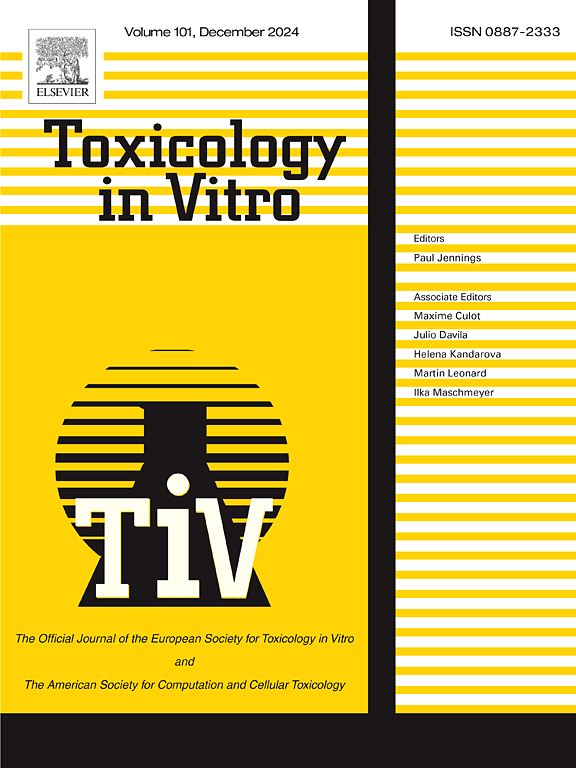Identification of Beauvericin metabolites using rat and human liver microsomes and in vivo urinary excretion study in rats for biomonitoring application
IF 2.7
3区 医学
Q3 TOXICOLOGY
引用次数: 0
Abstract
Beauvericin (BEA), an emerging mycotoxin, belongs to a class characterized by a cyclic depsipeptide ring structure, commonly produced by fungal species like Fusarium sp. and Beauveria bassiana. BEA is known for contaminating cereals and grains (wheat, maize). Humans might be exposed to BEA through contaminated food. Biomonitoring is a valuable method for assessing environmental and occupational exposure to specific chemicals. These studies measure chemical biomarkers to quantify exposure for public health risk assessment. However, identifying specific and sensitive chemical biomarkers for BEA exposure remains challenging. In the present study, metabolites of BEA were identified through in vitro metabolism studies conducted in the rat (RLM) and human liver microsomes (HLM) using the liquid chromatography-high resolution mass spectrometry (LC-HRMS) technique. Seventeen metabolites were characterized, showcasing products of oxidation, reduction, and deamination reactions. Predominantly, oxidative metabolites resulting from mono‑oxygenation, di‑oxygenation, and tri‑oxygenation were observed. The metabolites in RLM primarily consisted of mono and di‑oxygenated forms, while in HLM, tri‑oxygenated and demethylated products were also found. Furthermore, in vivo excretion study in rat urine samples confirmed the presence of oxygenated metabolites detected in the in vitro samples. Consequently, the study suggests that oxygenated metabolites of BEA could serve as useful biomarkers for conducting future biomonitoring studies.
利用大鼠和人类肝脏微粒体鉴定蒲公英代谢物,并对大鼠进行体内尿排泄研究,以用于生物监测。
牛维菌素(BEA)是一种新出现的霉菌毒素,属于环状去肽环结构的一类毒素,通常由镰刀菌属和牛维菌属等真菌产生。众所周知,BEA 会污染谷物(小麦、玉米)。人类可能会通过受污染的食物接触到 BEA。生物监测是评估特定化学品的环境和职业暴露的重要方法。这些研究通过测量化学生物标志物来量化暴露量,从而进行公共健康风险评估。然而,确定暴露于 BEA 的特异性和敏感性化学生物标志物仍然具有挑战性。本研究采用液相色谱-高分辨质谱(LC-HRMS)技术,通过对大鼠(RLM)和人体肝脏微粒体(HLM)进行体外代谢研究,确定了 BEA 的代谢物。对 17 种代谢物进行了表征,展示了氧化、还原和脱氨反应的产物。主要观察到了一氧、二氧和三氧反应产生的氧化代谢物。RLM 中的代谢物主要包括单氧和二氧形式,而在 HLM 中也发现了三氧和脱甲基产物。此外,对大鼠尿样进行的体内排泄研究证实了体外样本中检测到的含氧代谢物的存在。因此,这项研究表明,BEA 的含氧代谢物可作为有用的生物标志物,用于今后的生物监测研究。
本文章由计算机程序翻译,如有差异,请以英文原文为准。
求助全文
约1分钟内获得全文
求助全文
来源期刊

Toxicology in Vitro
医学-毒理学
CiteScore
6.50
自引率
3.10%
发文量
181
审稿时长
65 days
期刊介绍:
Toxicology in Vitro publishes original research papers and reviews on the application and use of in vitro systems for assessing or predicting the toxic effects of chemicals and elucidating their mechanisms of action. These in vitro techniques include utilizing cell or tissue cultures, isolated cells, tissue slices, subcellular fractions, transgenic cell cultures, and cells from transgenic organisms, as well as in silico modelling. The Journal will focus on investigations that involve the development and validation of new in vitro methods, e.g. for prediction of toxic effects based on traditional and in silico modelling; on the use of methods in high-throughput toxicology and pharmacology; elucidation of mechanisms of toxic action; the application of genomics, transcriptomics and proteomics in toxicology, as well as on comparative studies that characterise the relationship between in vitro and in vivo findings. The Journal strongly encourages the submission of manuscripts that focus on the development of in vitro methods, their practical applications and regulatory use (e.g. in the areas of food components cosmetics, pharmaceuticals, pesticides, and industrial chemicals). Toxicology in Vitro discourages papers that record reporting on toxicological effects from materials, such as plant extracts or herbal medicines, that have not been chemically characterized.
 求助内容:
求助内容: 应助结果提醒方式:
应助结果提醒方式:


